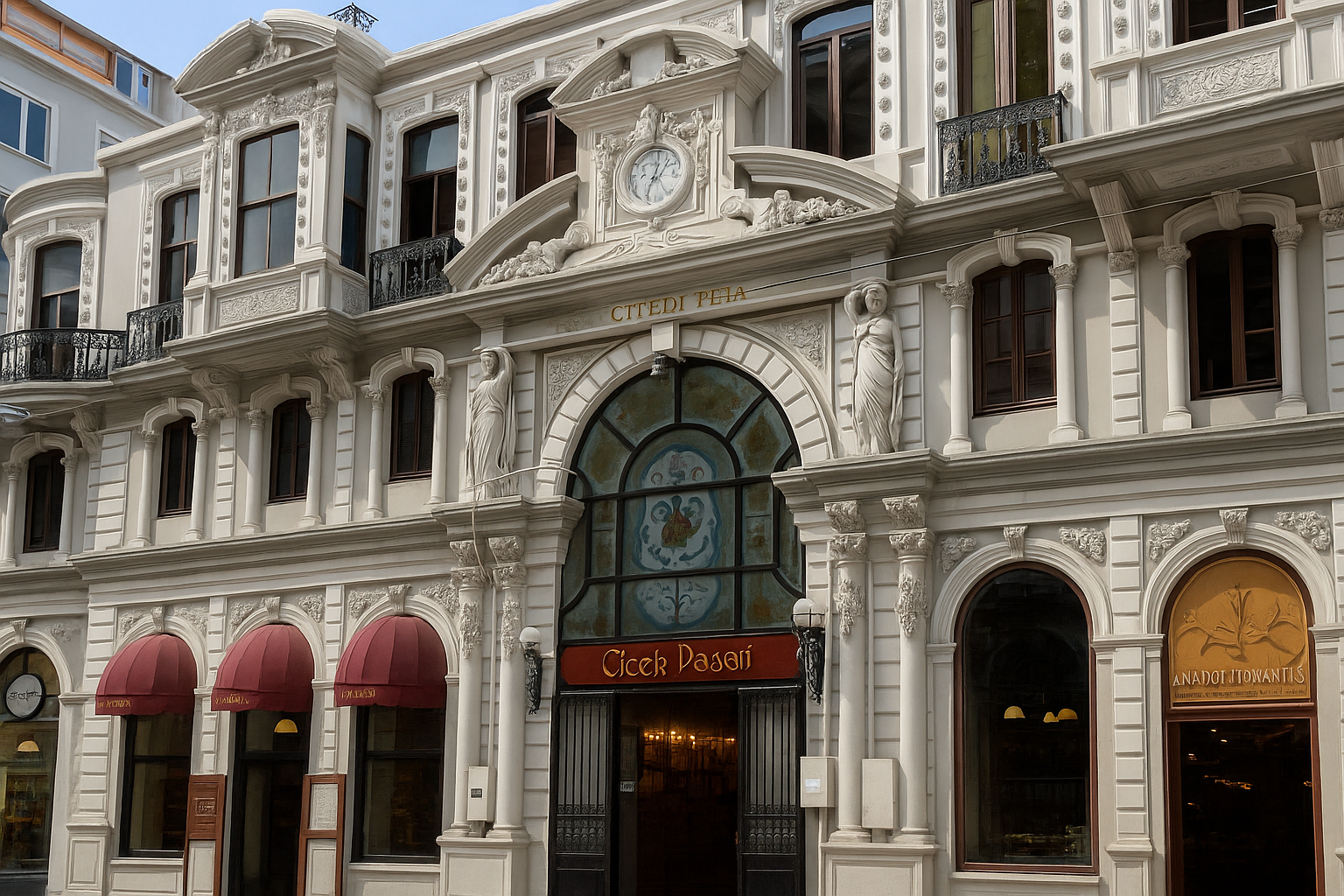
Tarihi Çiçek Pasajı (Cité de Péra)
HISTORICAL BACKGROUND AND SIGNIFICANCE
Tarihi Çiçek Pasajı, also known as Cité de Péra, is a historic arcade located in the bustling district of Beyoğlu, Istanbul. Originally built in 1876, it was designed by the renowned architect, A. M. de Montferrand, who also contributed to the design of the famous Russian Orthodox Church nearby. The passage was initially constructed as a passage for the wealthy elite of the Ottoman Empire, serving as a hub for flower shops, hence its name, which translates to "Historical Flower Passage."
The building has a rich history, having undergone various transformations over the years. It was originally a place where flowers were sold, but as time progressed, it evolved into a vibrant marketplace filled with restaurants, cafés, and shops. The passage has witnessed significant events in Turkish history, including the tumultuous years of the early 20th century and the cultural shifts that followed the establishment of the Republic of Turkey in 1923.
ARCHITECTURAL FEATURES AND DESIGN ELEMENTS
The architectural design of Tarihi Çiçek Pasajı is a stunning example of the neo-classical style that was prevalent in the late 19th century. The building features a glass roof that allows natural light to flood the interior, creating a warm and inviting atmosphere. The façade is adorned with intricate decorations, including wrought iron details and elegant arches that reflect the architectural trends of the time.
Inside, visitors are greeted by a long, narrow corridor lined with charming shops and eateries. The passage is characterized by its high ceilings and beautiful tile work, which adds to the overall aesthetic appeal. The use of glass and iron in the construction not only enhances the visual experience but also symbolizes the blend of Western and Eastern influences that define Istanbul's architectural landscape.
CULTURAL AND RELIGIOUS IMPORTANCE
Tarihi Çiçek Pasajı holds a significant place in the cultural fabric of Istanbul. It is not just a marketplace but a social hub where locals and tourists alike come to experience the vibrant atmosphere of the city. The passage reflects the multicultural essence of Istanbul, showcasing a blend of various culinary traditions, particularly those of the Ottoman and modern Turkish cuisines.
Additionally, the passage has been a site of cultural gatherings and celebrations, often hosting events that highlight the diverse heritage of the city. The presence of numerous restaurants and cafés allows visitors to indulge in traditional Turkish dishes, making it a culinary landmark in its own right.
VISITOR EXPERIENCE AND WHAT TO EXPECT
When visiting Tarihi Çiçek Pasajı, expect to be enveloped in a lively atmosphere filled with the sounds of laughter, clinking glasses, and the aroma of delicious food. The passage is home to a variety of establishments, from casual eateries to more upscale dining options, offering everything from mezes (appetizers) to fresh seafood.
As you stroll through the passage, take the time to explore the unique shops selling flowers, spices, and local handicrafts. The friendly shopkeepers often engage with visitors, sharing stories about their products and the history of the passage. The vibrant ambiance is perfect for leisurely exploration, and many visitors find themselves lingering over a cup of Turkish tea or coffee while soaking in the surroundings.
INTERESTING FACTS AND ANECDOTES
One of the most fascinating aspects of Tarihi Çiçek Pasajı is its connection to the famous Turkish writer, Orhan Pamuk, who often referenced the passage in his works. It is said that the passage inspired many of his characters and narratives, reflecting the essence of Istanbul's complex identity.
Additionally, the passage has been featured in various films and television series, further solidifying its status as a cultural icon. The vibrant nightlife in and around the passage has made it a popular spot for both locals and tourists, especially in the evenings when the restaurants come alive with music and laughter.
PRACTICAL VISITING INFORMATION
Tarihi Çiçek Pasajı is open daily, typically from 10:00 AM to 10:00 PM, although individual shop hours may vary. The best time to visit is during the late afternoon or early evening when the passage is bustling with activity, and the ambiance is at its peak.
To make the most of your visit, consider taking a guided tour that includes the passage as part of a larger exploration of Beyoğlu. This will provide you with deeper insights into the history and significance of the area. Additionally, be sure to try some of the local delicacies, such as the famous "meze" platters or freshly caught fish, which are highlights of the dining experience here.
In conclusion, Tarihi Çiçek Pasajı is more than just a passage; it is a living testament to Istanbul's rich history and cultural diversity. Whether you are a history buff, a foodie, or simply looking to soak in the vibrant atmosphere of the city, a visit to this iconic location is sure to be a memorable experience.